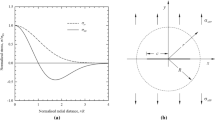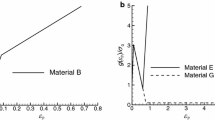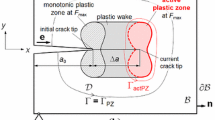Abstract
The repair or replacement of defective structures can be avoided if it can be shown that the defects will not grow in service. An approximate method for assessing the onset of crack growth in an elastic plastic material is available for the case when the load and strain controlled loads are in the same mode. However, there have been no previous investigations of the case when they are in different modes.
Suitable parameters for characterising the onset of crack growth in an elastic plastic material are the components of contour integrals around the tips. These have been evaluated for a small crack in a work hardening elastic plastic plate under various combinations of load controlled and strain controlled uniform tensile and shear loadings. The enhancement factor over the value for a linear elastic material is most marked for load controlled shear and for strain controlled shear combined with load controlled tension. Much of this enhancement is associated with the increased plastic zone size due to the increased equivalent stress in shear. A simplified method which ignores this effect is found not to be conservative. A method for allowing the simplified procedures to take account of this effect has been presented which gives a fairly close approximation to the finite element results until yield is attained over the remaining section. For larger strains cracks may be pessimistically assessed by taking the worst case between treating all the loading as tensile and treating it all as shear, or by using multiaxial equilibrium equations and multiaxial stress strain curves for both the net and gross sections.
Résumé
On peut éviter la réparation ou le remplacement de structures défectueuses si l'on peut démontrer que des défauts ne se prolongeront pas en service. Il existe une méthode approchée pour établir le démarrage de la croissance d'une fissure dans un matériau élasto-plastique, pour le cas où les sollicitations régies par les charges et par la déformation sont du même mode. Toutefois, il n'y a pas encore eu de recherche pour le cas où elles sont de modes différents. Pour caractériser le démarrage de la croissance d'une fissure dans un matériau élasto-plastique, les composantes des intégrales de contour qui décrivent la zone au voisinage des extrémités de la fissure sont des paramètres applicables. On a procédé à leur évaluation pour une petite fissure dans un matériau élastoplastique sujet à écrouissage, soumise à diverses combinaisons de mise en charge par traction et par cisaillement à charges contrôlées et à déformation contrôlée. Le facteur d'expansion par rapport à la valeur correspondant à un matériau linéaire élastique est surtout marqué dans le cas d'un cisaillement à charge contrôlée combiné à une traction à charge contrôlée. La majeure partie de cette expansion est associée à l'accroissement de la taille de la zone plastique, dû à l'augmentation de la tension équivalent en cisaillement. Il apparaît qu'une méthode qui néglige cet effect est peu fiable. On présente une méthode qui permet de tenir compte de cet effet dans une procédure simplifiée, ce qui donne une approximation assez précise aux résultats obtenus par éléments finis jusqu'au stade où la déformation plastique gagne toute la section restante.
Dans le cas de grandes déformations, on peut établir les conditions pessimistes de fissuration en considérant le cas le plus défavorable entre traiter toutes les sollicitations comme des mises en traction ou des mises en cisaillement ou encore utiliser les équations d'équilibre multiaxial et les courbes tension-dilatation multiaxiales à la fois pour la section nette et pour la section totale.
Similar content being viewed by others
References
T.K. Hellen and W.S. Blackburn, International Journal of Fracture 21 (1986) to be published.
T.K. Hellen and W.S. Blackburn, International Journal of Fracture 11 (1975) 605–617.
S. Nemat-Nasser, Proceedings 2nd International Conference on Numerical Methods in Fracture (ed.) A.R. Luxmoore and D.R.J. Owen, Pinewood Press, Swansea (1980).
J.K. Knowles and E. Sternberg, Archive Rational Mechanics and Analysis 44 (1972) 178–211.
J.R. Eshelby, Solid State Physics 3 (1956).
W.S. Blackburn, T.K. Hellen and A.D. Jackson, International Journal of Fracture 13 (1977) 183–199.
T.K. Hellen, Proceedings 3rd International Conference on Numerical Methods in Fracture (1984) (ed.) A.R. Luxmoore and D.R.J. Owen, Pinewood Press, Swansea (1984).
G. Moyser and T.K. Hellen, BERSAFE, Volume 8, User's Guide to PLOPPER Level 3 (1985).
T.K. Hellen and P.G. Harper, BERSAFE, Volume 3, User's Guide to BERSAFE Phase III Level 3 (1985).
W.S. Blackburn, International Journal of Pressure Vessels and Piping, to be published.
W.S. Blackburn, International Journal of Fracture 3 (1967) 157–174.
D.J.F. Ewing, Private communication (1968).
R.A. Ainsworth, Engineering Fracture Mechanics 19 (1984) 632–642.
H. Kober, Dictionary of Conformal Representations, Dover, New York (1957).
E. Jahnke and F. Emde, Tables of Functions, Dover, New York (1945).
Author information
Authors and Affiliations
Rights and permissions
About this article
Cite this article
Blackburn, W.S. Contour integration around crack tips for combined mixed mode load and strain controlled loading of an elastic plastic material. Int J Fract 32, 93–104 (1986). https://doi.org/10.1007/BF00019786
Received:
Issue Date:
DOI: https://doi.org/10.1007/BF00019786




